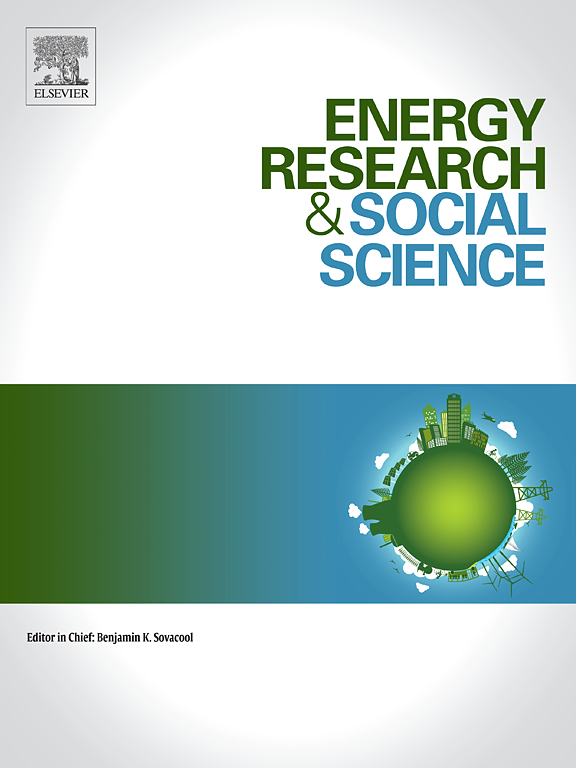能源系统弹性:制定能源政策制定的指导概念
IF 7.4
2区 经济学
Q1 ENVIRONMENTAL STUDIES
引用次数: 0
摘要
本文旨在定义能源系统弹性(ESR),以指导能源政策制定者设计、维护和改进能源系统。在过去的二十年里,弹性的概念变得越来越流行。特别是在能源系统设计中,ESR一词——有时也被称为能源弹性——经常出现在学术著作和公共政策领域,与能源可持续性、能源转型等主题一起出现。然而,文献很少为ESR提供规范性目标,因此它不足以指导能源政策制定的行动。在这项工作中,我们以一种结合技术特征、社会技术手段和道德目标的方式定义ESR。从弹性作为“反弹”的一般概念开始,并追踪弹性如何在能源系统中使用,然后我们说明了如何在文献中使用ESR,分析了一些提供明确ESR定义的研究,并制定了一个新的综合定义。包含技术特征、社会技术手段和道德目标,我们将ESR定义为能源系统在预期和意外中断中向前反弹的准备,以便通过可靠的工程技术、有效的管理和有利的社会制度提供充足和稳定的能源供应。然后,我们在能源政策制定中运用这一综合定义。最后,我们对本文进行了总结,并指出可能限制其研究结果影响的因素,即ESR只是能源系统设计中需要解决的一个方面。本文章由计算机程序翻译,如有差异,请以英文原文为准。
Energy system resilience: Formulating a guiding concept for energy policymaking
This paper aims to define energy system resilience (ESR) in a way that can guide energy policymakers in designing, maintaining, and improving energy systems. The concept of resilience has become increasingly popular in the last two decades. Particularly in energy system design, the term ESR – sometimes synonymously called energy resilience – often appears in academic works and public policy domains alongside themes such as energy sustainability, energy transition, etc. However, the literature rarely provides a normative goal for ESR, such that it is not sufficiently action-guiding for energy policymaking. In this work, we define ESR in a way that incorporates technical characteristics, socio-technical means, and an ethical goal. Beginning with the general conception of resilience as ‘bouncing back’, and tracing how resilience is used in energy systems, we then illustrate how ESR is used across the literature, analyse a selection of studies which provide explicit ESR definitions, and formulate a new comprehensive definition. Containing technical characteristics, socio-technical means, and an ethical goal, we define ESR as the readiness of an energy system to bounce forward amidst anticipated and unanticipated disruptions in order to provide a sufficient and stable energy supply through reliable engineering techniques, efficient management, and conducive social institutions. We then operationalise this comprehensive definition in energy policymaking. Finally, we provide a summary of this paper and indicate what might limit the impact of its findings, namely, that ESR is but one aspect to address in energy system design.
求助全文
通过发布文献求助,成功后即可免费获取论文全文。
去求助
来源期刊

Energy Research & Social Science
ENVIRONMENTAL STUDIES-
CiteScore
14.00
自引率
16.40%
发文量
441
审稿时长
55 days
期刊介绍:
Energy Research & Social Science (ERSS) is a peer-reviewed international journal that publishes original research and review articles examining the relationship between energy systems and society. ERSS covers a range of topics revolving around the intersection of energy technologies, fuels, and resources on one side and social processes and influences - including communities of energy users, people affected by energy production, social institutions, customs, traditions, behaviors, and policies - on the other. Put another way, ERSS investigates the social system surrounding energy technology and hardware. ERSS is relevant for energy practitioners, researchers interested in the social aspects of energy production or use, and policymakers.
Energy Research & Social Science (ERSS) provides an interdisciplinary forum to discuss how social and technical issues related to energy production and consumption interact. Energy production, distribution, and consumption all have both technical and human components, and the latter involves the human causes and consequences of energy-related activities and processes as well as social structures that shape how people interact with energy systems. Energy analysis, therefore, needs to look beyond the dimensions of technology and economics to include these social and human elements.
 求助内容:
求助内容: 应助结果提醒方式:
应助结果提醒方式:


